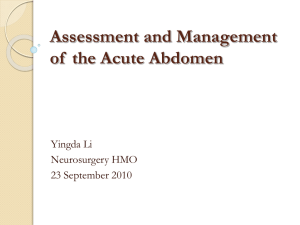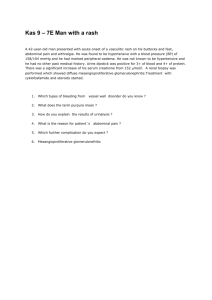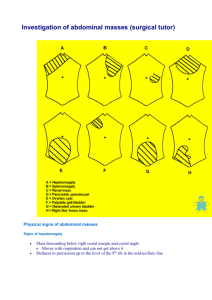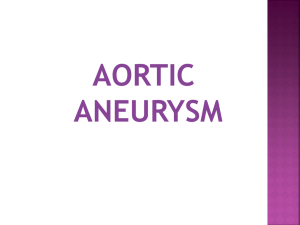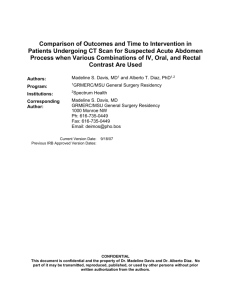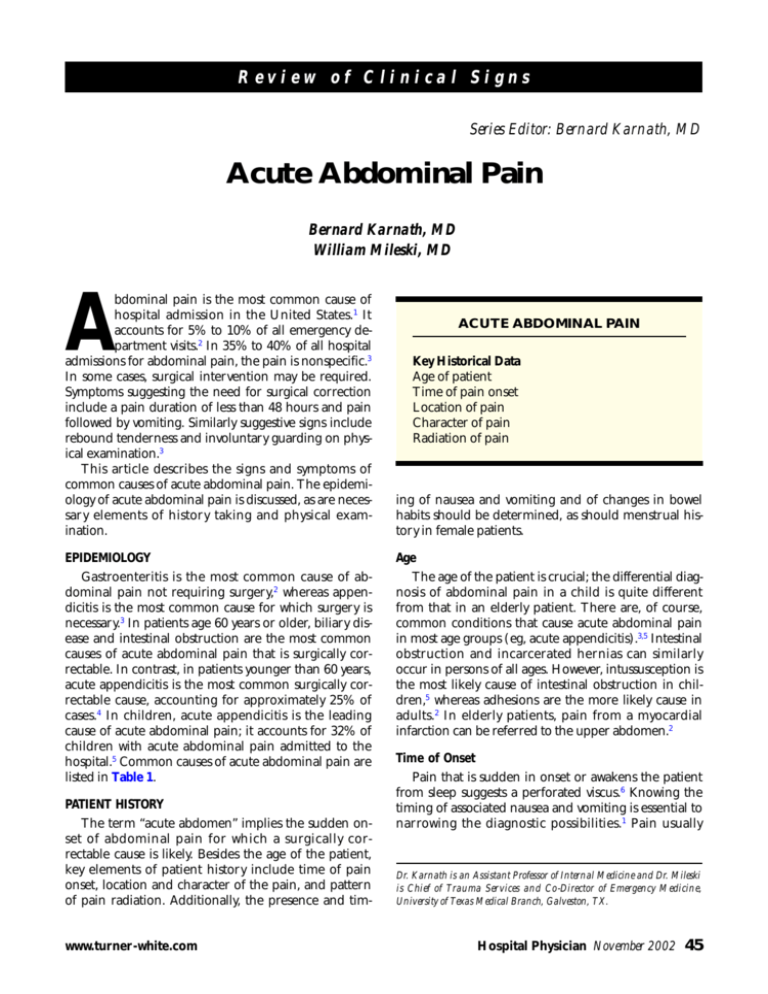
Review of Clinical Signs
Series Editor: Bernard Karnath, MD
Acute Abdominal Pain
Bernard Karnath, MD
William Mileski, MD
bdominal pain is the most common cause of
hospital admission in the United States.1 It
accounts for 5% to 10% of all emergency department visits.2 In 35% to 40% of all hospital
admissions for abdominal pain, the pain is nonspecific.3
In some cases, surgical intervention may be required.
Symptoms suggesting the need for surgical correction
include a pain duration of less than 48 hours and pain
followed by vomiting. Similarly suggestive signs include
rebound tenderness and involuntary guarding on physical examination.3
This article describes the signs and symptoms of
common causes of acute abdominal pain. The epidemiology of acute abdominal pain is discussed, as are necessary elements of history taking and physical examination.
A
EPIDEMIOLOGY
Gastroenteritis is the most common cause of abdominal pain not requiring surgery,2 whereas appendicitis is the most common cause for which surgery is
necessary.3 In patients age 60 years or older, biliary disease and intestinal obstruction are the most common
causes of acute abdominal pain that is surgically correctable. In contrast, in patients younger than 60 years,
acute appendicitis is the most common surgically correctable cause, accounting for approximately 25% of
cases.4 In children, acute appendicitis is the leading
cause of acute abdominal pain; it accounts for 32% of
children with acute abdominal pain admitted to the
hospital.5 Common causes of acute abdominal pain are
listed in Table 1.
PATIENT HISTORY
The term “acute abdomen” implies the sudden onset of abdominal pain for which a surgically correctable cause is likely. Besides the age of the patient,
key elements of patient history include time of pain
onset, location and character of the pain, and pattern
of pain radiation. Additionally, the presence and tim-
www.turner-white.com
ACUTE ABDOMINAL PAIN
Key Historical Data
Age of patient
Time of pain onset
Location of pain
Character of pain
Radiation of pain
ing of nausea and vomiting and of changes in bowel
habits should be determined, as should menstrual history in female patients.
Age
The age of the patient is crucial; the differential diagnosis of abdominal pain in a child is quite different
from that in an elderly patient. There are, of course,
common conditions that cause acute abdominal pain
in most age groups (eg, acute appendicitis).3,5 Intestinal
obstruction and incarcerated hernias can similarly
occur in persons of all ages. However, intussusception is
the most likely cause of intestinal obstruction in children,5 whereas adhesions are the more likely cause in
adults.2 In elderly patients, pain from a myocardial
infarction can be referred to the upper abdomen.2
Time of Onset
Pain that is sudden in onset or awakens the patient
from sleep suggests a perforated viscus.6 Knowing the
timing of associated nausea and vomiting is essential to
narrowing the diagnostic possibilities.1 Pain usually
Dr. Karnath is an Assistant Professor of Internal Medicine and Dr. Mileski
is Chief of Trauma Services and Co-Director of Emergency Medicine,
University of Texas Medical Branch, Galveston, TX.
Hospital Physician November 2002
45
Karnath & Mileski : Acute Abdominal Pain : pp. 45 – 50
Table 1. Common Causes of Acute Abdominal Pain
Upper abdominal pain
Acute cholecystitis
Acute pancreatitis
Perforated ulcer
Midabdominal pain
Epigastric
Intestinal obstruction
RUQ
LUQ
RLQ
LLQ
Mesenteric ischemia
Umbilical
Lower abdominal pain
Hypogastric
or
suprapubic
Acute appendicitis
Sigmoid diverticulitis
B
Gynecologic causes
A
Urologic causes
Figure 1. Abdominal sections. (A) The 4 abdominal quadrants.
(B) The epigastric, umbilical, and suprapubic (hypogastric)
regions. LLQ = left lower quadrant; LUQ = left upper quadrant;
RLQ = right lower quadrant; RUQ = right upper quadrant.
precedes vomiting when abdominal pain is from surgically correctable causes, whereas the reverse is true for
medical conditions such as gastroenteritis.
Location
The abdomen is divided into 4 quadrants, which are
further divided (with some overlap) into the epigastric,
periumbilical, and suprapubic regions (Figure 1).1 Right
upper quadrant pain is often reported by patients with
duodenal ulcers, acute pancreatitis, acute cholecystitis,
and acute hepatitis. Left upper quadrant pain is reported frequently by patients with gastritis, gastric ulcer,
acute pancreatitis, and splenic infarct or rupture. Right
lower quadrant pain is typically reported by patients with
acute appendicitis, and left lower quadrant pain by patients with diverticulitis. Gynecologic and urologic causes of acute abdominal pain can also present with lower
quadrant abdominal pain.
Character
The term “character” implies all the features of the
pain and usually can be determined by asking the
patient to describe the quality of the pain. The pain is
most often described as being sharp or dull and may
also be described as being cramping (ie, colicky). Colicky pain is defined as a rhythmic pain resulting from
intermittent spasms.7 Colicky abdominal pain is most
commonly associated with biliary disease, nephrolithiasis, and intestinal obstruction.1 Pain that begins as a dull,
poorly localized ache and progresses to a constant, welllocalized sharp pain indicates a surgically correctable
cause. A classic example is the pain of acute appendicitis, in which the pain initially begins as a poorly defined
46 Hospital Physician November 2002
dull pain in the periumbilical region and progresses to a
sharp, severe pain in the right lower quadrant.
PHYSICAL EXAMINATION
Inspection
The physical examination of patients with acute abdominal pain should begin with general observation.7 A
patient writhing in agony likely has colicky abdominal
pain caused by ureteral lithiasis. On the other hand, a
patient lying very still is more likely to have peritonitis,
and a patient who is leaning forward to relieve the pain
may have pancreatitis. The examiner should also inspect
the abdominal wall for surgical scars and evidence of
trauma, distention, masses, and hernias. The abdominal
wall is a commonly overlooked source of abdominal
pain. Other parts of the body also should be inspected.
For example, the eyes should be inspected for evidence of
scleral icterus, which may indicate hepatobiliary disease.
Auscultation
Auscultation of the abdomen is useful in assessing
peristalsis. Bowel sounds are widely transmitted throughout the abdomen. Therefore, it is not necessary to listen
in all 4 quadrants. It is recommended, however, that auscultation should last at least 1 minute. Bowel sounds are
typically high pitched, so the diaphragm of the stethoscope should be used.
Bowel sounds are classified as normal, hyperactive, or
hypoactive.8 Hypoactive bowel sounds are associated
with ileus, intestinal obstruction, and peritonitis. Intestinal obstruction can produce hyperactive bowel sounds,
www.turner-white.com
Karnath & Mileski : Acute Abdominal Pain : pp. 45 – 50
which are high-pitched tinkling sounds occurring at
brief intervals; they are very audible. Auscultation should
precede percussion and palpation.
Percussion
The technique of percussion is performed by firmly
pressing the index finger of one hand on the abdominal
wall while striking the abdominal wall with the other
index finger. The percussion note that is heard may be
described as dull, resonant, or hyperresonant. Percussion
over the liver will generate a dull note, whereas percussion over the gastric region will generate a hyperresonant
note because of the usual presence of a gastric air bubble. The technique of percussion also can be used to
determine liver span. Percussion has likewise been advocated as a more humane method of eliciting signs of
peritonitis.9
Generalized percussion is a useful method for detecting the presence of ascites or intestinal obstruction in a
distended abdomen. In the setting of ascites, a dull percussion note would be generated; in the setting of intestinal obstruction, a hyperresonant note would be
heard. If ascites is suspected, then a test for shifting dullness can be performed. Because ascites typically sinks
with gravity, percussion of the flanks generates a dull
note and percussion of the periumbilical region generates a resonant note in a supine patient. The test for
shifting dullness involves having the patient shift to a lateral decubitus position and then performing percussion
again; the area of resonance should shift upward.
Palpation
Before palpating the abdomen, the examiner should
ask the patient to point directly to the area that hurts
most and then avoid palpating that area until absolutely
necessary. Palpation may be difficult in a patient who has
guarding, defined by spasms of the abdominal muscles.1
Guarding can be voluntary or involuntary. Voluntary
guarding occurs when there is conscious elimination of
muscle spasms, and involuntary guarding is reported
when the spasm response cannot be eliminated, which
usually indicates diffuse peritonitis. Rebound tenderness
is elicited by pressing the abdominal wall deeply with the
fingers and then suddenly releasing the pressure.1 Pain
on this abrupt release of steady pressure is known as
Blumberg’s sign and indicates the presence of peritonitis. Asking the patient to cough is another method of
eliciting signs of peritonitis.10
SPECIFIC DISORDERS
Upper Abdominal Pain
Common causes of acute abdominal pain in the
www.turner-white.com
Figure 2. Illustration of how Murphy’s sign is elicited.
upper abdomen include acute cholecystitis, acute pancreatitis, and perforated ulcers. Pain usually overlaps
the left and right upper quadrants.
Acute cholecystitis. Cholecystitis results from bile stasis
secondary to obstruction of the cystic duct. Cholelithiasis
and cholecystitis are considered diseases of adulthood.
Women are more likely to develop cholelithiasis than are
men.11 Although acute cholecystitis is an acute inflammatory process, bacterial infection is not a cause in approximately half of cases.11 When bacterial invasion does occur, ascending cholangitis can result. Charcot’s triad of
right upper quadrant abdominal pain, fever, and jaundice is common in patients with ascending cholangitis.11
In patients with cholecystitis, Murphy’s sign can be elicited by having the patient take a deep breath while the
right subcostal area is palpated (Figure 2).11 Abrupt cessation of inspiration secondary to pain is considered a positive Murphy’s sign.
Acute pancreatitis. Pancreatitis results from autodigestion of pancreatic tissue by proteolytic enzymes released
into the pancreatic parenchyma. Initially, the pancreas
becomes edematous. In more severe cases of hemorrhagic pancreatitis, there is parenchymal necrosis and hemorrhage. Retroperitoneal dissection of blood can result in
bluish discoloration of the flanks (ie, Turner’s sign) or of
the periumbilical region (ie, Cullen’s sign).11
Biliary pancreatitis secondary to cholelithiasis is most
commonly encountered in women age 50 years and
older in a community hospital setting, whereas alcoholic pancreatitis is most commonly seen in men age
30 to 45 years in an urban hospital setting.11 Patients
most commonly report epigastric pain, nausea, and
vomiting; the pain is constant and boring in nature.
Bowel sounds are decreased, and there is lack of rigidity
or rebound tenderness.
Hospital Physician November 2002
47
Karnath & Mileski : Acute Abdominal Pain : pp. 45 – 50
Figure 3. Radiograph of a patient with a perforated peptic
ulcer showing free air under both diaphragms.
Figure 4. Abdominal radiograph showing dilated loops of
small intestine indicative of an obstruction.
Perforated peptic ulcer. Patients with perforated
peptic ulcers commonly experience sudden onset of
severe epigastric pain, which becomes generalized after
a few hours to involve the entire abdomen.6,7 Perforated
peptic ulcers have a perioperative mortality rate of
23%.4 Observation typically reveals a patient lying quietly and breathing shallowly. The abdomen is rigid and
board-like. Guarding is maximal at the site of perforation. Upright chest radiography is the most appropriate
study for the detection of free intraperitoneal air, an
indication of a perforated viscus (Figure 3).6,7
Midabdominal Pain
Common causes of midabdominal pain include intestinal obstruction, mesenteric ischemia, and early
appendicitis. The pain of early appendicitis eventually
migrates to the right lower quadrant and so will not be
discussed here.
Intestinal obstruction. Intestinal obstruction can be
either mechanical or nonmechanical.12 Mechanical
obstruction results from gallstones, adhesions, hernias,
volvulus, intussusception, or tumors, whereas nonmechanical obstruction results from intestinal infarction or
occurs after surgery as a paralytic ileus. Obstruction high
in the small intestine results in severe abdominal pain in
the epigastric or umbilical region with bilious vomiting.
Distention of the abdomen is not an early feature. Obstruction located lower in the small intestine results in
48 Hospital Physician November 2002
less severe abdominal pain. Vomiting is a late feature
and may be feculent. The differential diagnosis of obstruction of the small intestine includes strangulated
hernia, volvulus, mesenteric thrombus, and gallstone
ileus. An abdominal radiograph of a distal obstruction
of the small intestine will show a dilated loop (Figure 4).
Obstruction of the large intestine often has an insidious onset. Pain is less severe than in the small intestine,
and vomiting is infrequent. Distention of the abdomen
is common. The main causes of obstruction of the large
intestine leading to midabdominal pain are cancer of
the colon, diverticulitis, and volvulus. Change in bowel
habits, weight loss, abdominal pain, and rectal bleeding
are highly suggestive of colon cancer. Diverticulitis,
which will be discussed more fully as a cause of lower
abdominal pain, presents as a fixed and tender left
lower quadrant mass. Sigmoid volvulus is the most common type of colonic volvulus; symptoms begin gradually
and include cramping abdominal pain, followed by
obstipation.
Mesenteric ischemia. Mesenteric ischemia presents
with acute diffuse midabdominal pain, vomiting, decreased bowel sounds, and distention resulting from
intestinal obstruction. The abdominal pain of acute
mesenteric ischemia is out of proportion to physical
examination findings.2 Abdominal distention is a late
www.turner-white.com
Karnath & Mileski : Acute Abdominal Pain : pp. 45 – 50
A
Figure 6. Illustration of how the obturator sign is typically
elicited.
B
Figure 5. Illustration of how the psoas sign is typically elicited. (A) Standard method. (B) Alternate method.
sign indicative of gangrene. Signs of peritoneal irritation also indicate gangrene.
Lower Abdominal Pain
Common causes of lower abdominal pain include
sigmoid diverticulitis, acute appendicitis, and gynecologic and urologic causes. Diverticulitis typically presents as left lower quadrant pain, and appendicitis typically presents as right lower quadrant pain.
Diverticulitis. Diverticulitis is an acute inflammation
of a colonic diverticulum, which is a small saclike outpouching of the mucosa through the colonic muscle.
Diverticulitis typically presents as left lower quadrant
pain. The pain is usually described as a cramping sensation. There may be associated fever.
Appendicitis. The peak incidence of appendicitis
occurs in the second decade of life.13 The differential
diagnosis is broad, and errors in diagnosis are common. The diagnostic error rate can reach 23% in men
and 42% in women.13 Patients who are seen within the
first few hours of pain onset report poorly defined constant pain in the periumbilical region. As the disease
progresses, the pain shifts from the periumbilical
www.turner-white.com
region to the right lower quadrant in a region known
as McBurney’s point, which is located two thirds of the
distance along a line drawn from the umbilicus to the
right anterior superior iliac spine.14 The pain is relieved somewhat when patients assume a right lateral
decubitus position with slight hip flexion.
Abdominal tenderness is the most likely physical finding. Voluntary guarding in the right lower quadrant is
common. Rovsing’s sign can be elicited by palpating
deeply in the left iliac area and observing for referred
pain in the right iliac fossa. When present, the psoas and
obturator signs also are helpful in establishing a diagnosis of appendicitis.13 The psoas sign is pain elicited by
extending the right hip while the patient is in the left lateral decubitus position (Figure 5A).13 Alternatively, while
in the supine position, the patient can lift the right thigh
against the examiner’s hand, which is placed above the
knee (Figure 5B).13 The obturator sign is pain elicited by
flexing the patient’s right thigh at the hip with the knee
flexed and then internally rotating the hip (Figure 6).13
Right-sided rectal tenderness may also be elicited on
rectal examination of patients with acute appendicitis.
Other Causes of Abdominal Pain
Abdominal aortic aneurysm. Rupture of an abdominal aortic aneurysm most commonly produces symptoms of abdominal pain and backache; hypotension is
also typically present. There is a 71% perioperative
mortality rate associated with rupture of these aneurysms.4 Physical examination of the abdomen must be
performed to detect a pulsatile mass.
Nephrolithiasis. Ureteral colic accounts for approximately 4% of patients who develop acute abdominal
pain.3,4 Colicky pain begins in the upper lumbar region
and radiates laterally around the abdomen to the
inguinal region. The patient is often writhing in pain.
Findings of a normal appetite, short duration of pain,
Hospital Physician November 2002
49
Karnath & Mileski : Acute Abdominal Pain : pp. 45 – 50
Table 2. Signs in Patients with Acute Abdominal Pain
Sign
Description
Clinical Correlation
Guarding
Spasms of the abdominal muscle
Peritonitis (ruptured viscus)
Voluntary
Conscious elimination of spasms possible
Involuntary
Conscious elimination of spasms not possible
Blumberg’s sign
(rebound tenderness)
Elicited by pressing the abdominal wall deeply and then
suddenly releasing and observing for pain
Peritonitis (ruptured viscus)
Murphy’s sign
Elicited by having the patient take a deep breath while
the right subcostal area is palpated and observing for
abrupt cessation of inspiration because of pain
Cholecystitis
Turner’s sign
Retroperitoneal dissection of blood resulting in bluish
discoloration of the flanks
Pancreatitis
Cullen’s sign
Retroperitoneal dissection of blood resulting in bluish
discoloration of the periumbilical region
Pancreatitis
Psoas sign
Elicited by extending the right hip while the patient is in
the left lateral decubitus position and observing for pain
Appendicitis
Obturator sign
Elicited by flexing the patient’s right thigh at the hip with
the knee flexed and then internally rotating the hip and
observing for pain
Appendicitis
Rovsing’s sign
Elicited by palpating deeply in the left iliac area and
observing for referred pain in the right iliac fossa
Appendicitis
lumbar tenderness, and hematuria are highly suggestive of acute ureteral colic.15
SUMMARY
In most cases, taking a careful history and performing a thorough physical examination can elicit the exact
cause of acute abdominal pain. For abdominal pain correctable by surgery, symptoms generally include a pain
duration of less than 48 hours and pain followed by
vomiting. Pertinent signs include involuntary guarding
and rebound tenderness on physical examination. Certain specific clinical signs (Table 2) detected on physical
examination can aid in narrowing the differential possibilities.
HP
REFERENCES
1. Martin RF, Rossi RL. The acute abdomen. An overview
and algorithms. Surg Clin North Am 1997;77:1227–43.
2. Sanson TG, O’Keefe KP. Evaluation of abdominal pain in
the elderly. Emerg Med Clin North Am 1996;14:615–27.
3. Brewer BJ, Golden GT, Hitch DC, et al. Abdominal pain.
An analysis of 1,000 consecutive cases in a university hospital emergency room. Am J Surg 1976;131:219–23.
4. Irvin TT. Abdominal pain: a surgical audit of 1190 emergency admissions. Br J Surg 1989;76:1121–5.
5. Bell R. Diagnosing the causes of abdominal pain in children. Practitioner 1996;240:598–601, 602.
6. al-Musawi D, Thompson J. The important signs in acute
abdominal pain. Practitioner 2000:244:312–4, 316–8, 320.
7. Murtagh J. Acute abdominal pain: a diagnostic approach.
Aust Fam Physician 1994;23:358–61, 364–74.
8. Interpreting abnormal abdominal sounds. Nursing 2000;
30:28.
9. Silen W. Cope’s early diagnosis of the acute abdomen.
20th ed. New York: Oxford University Press; 2000.
10. Bennett DH, Tambeur LJ, Campbell WB. Use of coughing test to diagnose peritonitis. BMJ 1994;308:1336.
11. Moscati RM. Cholelithiasis, cholecystitis, and pancreatitis. Emerg Med Clin North Am 1996;14:719–37.
12. Sheridan JL. Obstructions of the intestinal tract. Nurs
Clin North Am 1975;10:147–55.
13. Graffeo CS, Counselman FL. Appendicitis. Emerg Med
Clin North Am 1996;14:653–71.
14. Kozol RA, Farmer DL, Tennenberg SD, Mulligan M. Surgical pearls. Philadelphia: FA Davis; 1999.
15. Eskelinen M, Ikonen J, Lipponen P. Usefulness of historytaking, physical examination and diagnostic scoring in
acute renal colic. Eur Urol 1998;34:467–73.
Copyright 2002 by Turner White Communications Inc., Wayne, PA. All rights reserved.
50 Hospital Physician November 2002
www.turner-white.com


